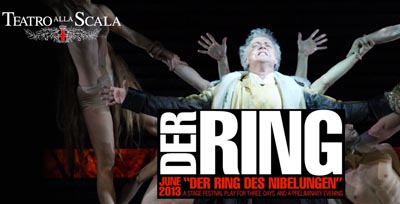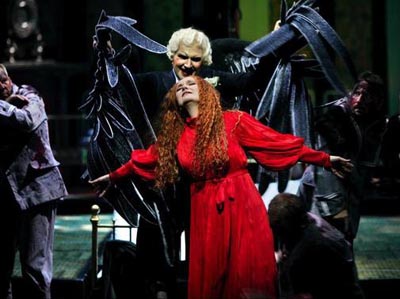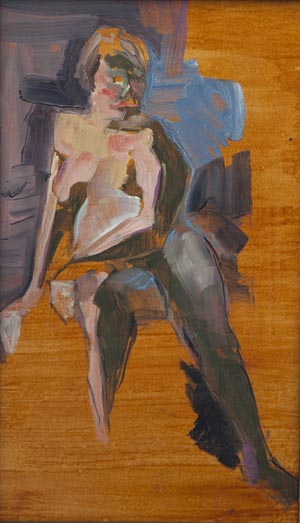
by Christina Waters | Jul 6, 2013 | Art, Home |
 Der Ring des Nibelungen—affectionately known to English-speakers as “the Ring,” is not only a transcendent marathon of four very long operas, but arguably one of the artistic masterworks of Western civilization. Hence, I can be forgiven for having saved up a chunk of change, flown to Milan two weeks ago and spent eight days in the fashion capital of the known world gearing up for a memorable musical experience. After feasting my eyes on gorgeous people (okay, men), imbibing my fair share of an alluring crimson liquid known as Campari, and sampling a few choice pastas—I made time to dress up, strap on some high heels and click, click, click my way across the cobblestones to Teatro alla Scala (two blocks from my hotel). There I joined smartly-dressed pilgrims from all over the globe for four nights of ravishing opera conducted by Daniel Barenboim and written 150 years ago by the controversial genius Richard Wagner.
Der Ring des Nibelungen—affectionately known to English-speakers as “the Ring,” is not only a transcendent marathon of four very long operas, but arguably one of the artistic masterworks of Western civilization. Hence, I can be forgiven for having saved up a chunk of change, flown to Milan two weeks ago and spent eight days in the fashion capital of the known world gearing up for a memorable musical experience. After feasting my eyes on gorgeous people (okay, men), imbibing my fair share of an alluring crimson liquid known as Campari, and sampling a few choice pastas—I made time to dress up, strap on some high heels and click, click, click my way across the cobblestones to Teatro alla Scala (two blocks from my hotel). There I joined smartly-dressed pilgrims from all over the globe for four nights of ravishing opera conducted by Daniel Barenboim and written 150 years ago by the controversial genius Richard Wagner.
Wagner did not disappoint. He simply cannot. Barenboim was not only superb in guiding a super-sized orchestra through 21 hours of difficult music, but his expansive phrasing—each opera ran at least 15 minutes longer than any versions I’d heard before—coaxed nuance upon nuance, and deepened meanings at every possible chromatic juncture. The master and his interpreter were without question the stars of La Scala’s 2013 production. So now I can remove the gloves.
High on the possibilities of digital special effects, postmodern visual concept and staging overkill, the Ring’s director Guy Cassiers almost ruined (more…)

by Christina Waters | Sep 5, 2012 | Art, Home |
 In his final opera, Parsifal—whose motifs had been built over a thirty-year period—Wagner fulfilled his vision of operatic “music theater” as something that would go far beyond the classical notion of a drama told in song and music.
In his final opera, Parsifal—whose motifs had been built over a thirty-year period—Wagner fulfilled his vision of operatic “music theater” as something that would go far beyond the classical notion of a drama told in song and music.
The Parsifal of this season’s Bayreuth Festival—direction by Stefan Herheim and set design by Heike Scheele—was in clear and stunning resonance with Wagner’s intention, and used electrifying manipulation of sets, lighting, costume, movement, and voice to achieve a fusion of space, time, and music.
When this production was first mounted several years ago it produced shock and awe. This season the sight of crimson National Socialist banners unfurling swastikas from the ceiling, while the young Parsifal rises from center stage in (more…)

by Christina Waters | Feb 29, 2012 | Art |
 Chris Cravey and Ari Finkelstein—friends, artists, over-achievers—will take over the Eduardo Carrillo Gallery @ the UCSC Art Department for a week starting March 1. The duo will unleash Collections: Figurative Sculpture, Drawings and Paintings upon a world hungry for enlightened visual culture.
Chris Cravey and Ari Finkelstein—friends, artists, over-achievers—will take over the Eduardo Carrillo Gallery @ the UCSC Art Department for a week starting March 1. The duo will unleash Collections: Figurative Sculpture, Drawings and Paintings upon a world hungry for enlightened visual culture.
Come take a look. A reception for the artists happens this Sunday, March 4th @ 5pm.
The Carrillo Gallery is an intimate exhibition space adjoining the central quad at the Baskin Arts Complex, across the drive from the Performing Arts Theater, UCSC. For more about the late Art professor emeritus, Eduardo Carrillo, his life and work, go here.
[A. Finkelstein]
by Christina Waters | Feb 28, 2012 | Art |

by Christina Waters | Feb 19, 2012 | Art, Home |
 Pina Bausch was one of my heroes. Most of my life I tracked her conceptual innovations in choreography, and the creation of her Tanztheater company in Wuppertal Germany. Moving dance beyond the lexicons of ballet and even Graham’s modern dance tropes, Bausch used the body to explore the archetypes of animality. Her “dances” are in fact small narratives, riddles, myths and gems of erotic psychoanalysis. In the process she created nothing less than a poetics of pain.
Pina Bausch was one of my heroes. Most of my life I tracked her conceptual innovations in choreography, and the creation of her Tanztheater company in Wuppertal Germany. Moving dance beyond the lexicons of ballet and even Graham’s modern dance tropes, Bausch used the body to explore the archetypes of animality. Her “dances” are in fact small narratives, riddles, myths and gems of erotic psychoanalysis. In the process she created nothing less than a poetics of pain.
In her pieces, at once expressionist, avant garde, and laced with angular angst, Bausch transformed dance into an emotional incantation in which longing and long-limbed velocity were employed to invoke something like redemption. (more…)

by Christina Waters | Jan 31, 2012 | Art |
 If you adore the literary ingenuity of Charles Dickens, whose work marks the apogee of the English language, then you’ll be intrigued by the newest exploration of Dickens’ masterpiece, Bleak House, by celebrated scholar and UCSC professor John Jordan.
If you adore the literary ingenuity of Charles Dickens, whose work marks the apogee of the English language, then you’ll be intrigued by the newest exploration of Dickens’ masterpiece, Bleak House, by celebrated scholar and UCSC professor John Jordan.
Better yet, come hear Jordan talk about Dickens, nineteenth-century English narrative fiction and his new book, Supposing Bleak House — Thursday, February 2, 7pm @ Bookshop Santa Cruz.
[Photo credit: Carolyn Lagattuta/UC Santa Cruz]

 Der Ring des Nibelungen—affectionately known to English-speakers as “the Ring,” is not only a transcendent marathon of four very long operas, but arguably one of the artistic masterworks of Western civilization. Hence, I can be forgiven for having saved up a chunk of change, flown to Milan two weeks ago and spent eight days in the fashion capital of the known world gearing up for a memorable musical experience. After feasting my eyes on gorgeous people (okay, men), imbibing my fair share of an alluring crimson liquid known as Campari, and sampling a few choice pastas—I made time to dress up, strap on some high heels and click, click, click my way across the cobblestones to Teatro alla Scala (two blocks from my hotel). There I joined smartly-dressed pilgrims from all over the globe for four nights of ravishing opera conducted by Daniel Barenboim and written 150 years ago by the controversial genius Richard Wagner.
Der Ring des Nibelungen—affectionately known to English-speakers as “the Ring,” is not only a transcendent marathon of four very long operas, but arguably one of the artistic masterworks of Western civilization. Hence, I can be forgiven for having saved up a chunk of change, flown to Milan two weeks ago and spent eight days in the fashion capital of the known world gearing up for a memorable musical experience. After feasting my eyes on gorgeous people (okay, men), imbibing my fair share of an alluring crimson liquid known as Campari, and sampling a few choice pastas—I made time to dress up, strap on some high heels and click, click, click my way across the cobblestones to Teatro alla Scala (two blocks from my hotel). There I joined smartly-dressed pilgrims from all over the globe for four nights of ravishing opera conducted by Daniel Barenboim and written 150 years ago by the controversial genius Richard Wagner.




